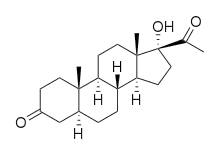5α-Pregnan-17α-ol-3,20-dione
5α-Pregnan-17α-ol-3,20-dione, also known as 17α-hydroxy-dihydroprogesterone (17‐OH-DHP) is an endogenous steroid.
 | |
| Names | |
|---|---|
| IUPAC name
(5α)-17-Hydroxypregnane-3,20-dione | |
| Other names | |
| Identifiers | |
3D model (JSmol) |
|
| ChEMBL | |
| ChemSpider | |
PubChem CID |
|
CompTox Dashboard (EPA) |
|
| |
| |
| Properties | |
| C21H32O3 | |
| Molar mass | 332.484 g·mol−1 |
Except where otherwise noted, data are given for materials in their standard state (at 25 °C [77 °F], 100 kPa). | |
| Infobox references | |
Function
5α-Pregnan-17α-ol-3,20-dione is the first intermediate product within the androgen backdoor pathway in which 17α-hydroxyprogesterone (17‐OHP) is 5α-reduced and finally converted to 5α-dihydrotestosterone (DHT) without testosterone intermediate. The subsequent intermediate products in the pathway are 5α-pregnane-3α,17α-diol-20-one, androsterone and 5α-androstane-3α,17β-diol.[7][8]
Biosynthesis
5α-Pregnan-17α-ol-3,20-dione is produced by 5α-reduction of 17-OHP. The reaction is catalyzed by SRD5A1/SRD5A2 enzymes.[2][9][10]
See also
- Androgen backdoor pathway
- 5α-Dihydrotestosterone
References
- "(5alpha)-17-Hydroxypregnane-3,20-dione - PubChem Compound Summary".
- Fukami M, Homma K, Hasegawa T, Ogata T (April 2013). "Backdoor pathway for dihydrotestosterone biosynthesis: implications for normal and abnormal human sex development". Developmental Dynamics. 242 (4): 320–9. doi:10.1002/dvdy.23892. PMID 23073980. S2CID 44702659.
- Asahina K, Suzuki K, Aida K, Hibiya T, Tamaoki B (February 1985). "Relationship between the structures and steroidogenic functions of the testes of the urohaze-goby (Glossogobius olivaceus)". General and Comparative Endocrinology. 57 (2): 281–92. doi:10.1016/0016-6480(85)90273-4. PMID 3156787.
- Gal M, Orly J (2014). "Selective inhibition of steroidogenic enzymes by ketoconazole in rat ovary cells". Clinical Medicine Insights. Reproductive Health. 8: 15–22. doi:10.4137/CMRH.S14036. PMC 4007567. PMID 24812532.
- Miller WL (January 2012). "The syndrome of 17,20 lyase deficiency". The Journal of Clinical Endocrinology and Metabolism. 97 (1): 59–67. doi:10.1210/jc.2011-2161. PMC 3251937. PMID 22072737.
- Hastings C, Hansson V (August 1981). "Kinetic properties of the soluble 3 alpha-hydroxysteroid dehydrogenase from rat testis and epididymis". Journal of Steroid Biochemistry. 14 (8): 705–11. doi:10.1016/0022-4731(81)90005-4. PMID 6946263.
- Miller WL, Auchus RJ (April 2019). "The "backdoor pathway" of androgen synthesis in human male sexual development". PLOS Biology. 17 (4): e3000198. doi:10.1371/journal.pbio.3000198. PMC 6464227. PMID 30943210.
- Wilson JD, Auchus RJ, Leihy MW, Guryev OL, Estabrook RW, Osborn SM, Shaw G, Renfree MB (February 2003). "5alpha-androstane-3alpha,17beta-diol is formed in tammar wallaby pouch young testes by a pathway involving 5alpha-pregnane-3alpha,17alpha-diol-20-one as a key intermediate". Endocrinology. 144 (2): 575–80. doi:10.1210/en.2002-220721. PMID 12538619.
- Reisch N, Taylor AE, Nogueira EF, Asby DJ, Dhir V, Berry A, Krone N, Auchus RJ, Shackleton CH, Hanley NA, Arlt W (October 2019). "Alternative pathway androgen biosynthesis and human fetal female virilization". Proceedings of the National Academy of Sciences of the United States of America. 116 (44): 22294–22299. doi:10.1073/pnas.1906623116. PMC 6825302. PMID 31611378.
- Kamrath C, Hochberg Z, Hartmann MF, Remer T, Wudy SA (March 2012). "Increased activation of the alternative "backdoor" pathway in patients with 21-hydroxylase deficiency: evidence from urinary steroid hormone analysis". The Journal of Clinical Endocrinology and Metabolism. 97 (3): E367–75. doi:10.1210/jc.2011-1997. PMID 22170725.
This article is issued from Wikipedia. The text is licensed under Creative Commons - Attribution - Sharealike. Additional terms may apply for the media files.